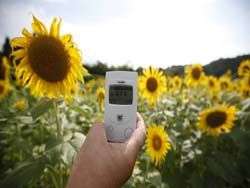Sunflower as adsorbent of cesium

Sunflower is reported to adsorb cesium, and the use for the decontamination of soil from the unstable isotope had been suggested [2]. This decontamination is important after the Fukushima disaster (2011) [3].
Several authors had indicated, that sunflowers are not efficient in the decontamination [4][5]. The mechanical removal of 3 cm layer of soil is reported to be more efficient [6].
Opposite points of view on the efficiency of decontamination of the area around the Fukushima nuclear plant by phytoremediation by sunflowers are presented in publications.
Freak
The promoters of sunflowers for decontamination should make the scientific test of the efficiency of the method they suggest. The initial contamination should be measured (for example, in Becquerel per square meter, of becquerel per kilogram of the soil), the contamination of the sunflowers after they grown-up and cut-out, and the contamination of the ground after the removal of the sunflowers. Also, the amount of radioactivity taking away with insects and birds, who consume the contaminated sunflowers, should be estimated.
While such measurements are not presented or do not confirm the significant reduction of the radioactivity of the ground after the removal of sunflowers, the proposals of the sunflowers for decontamination are qualified as freak, a pseudo–scientific project.
Keywords
Cesium, Fukushima disaster, Japan, Sunflower
References
- ↑ http://www.liveinternet.ru/users/3090603/post180970586/ 21 Августа 2011 г. 13:00. В Фукусиме расцвели тысячи подсолнухов, которые были высажены, на севере Японии, чтобы помочь борьбе с излучением на атомной станции. ..
- ↑ http://www.ncbi.nlm.nih.gov/pubmed/16630674 Soudek P, Valenová S, Vavríková Z, Vanek T. (137)Cs and (90)Sr uptake by sunflower cultivated under hydroponic conditions. J Environ Radioact. 2006;88(3):236-50. Epub 2006 Apr 21. The (90)Sr and (137)Cs uptake by the plant Helianthus annuus L. was studied during cultivation in a hydroponic medium. The accumulation of radioactivity in plants was measured after 2, 4, 8, 16 and 32 days of cultivation. About 12% of (137)Cs and 20% of (90)Sr accumulated during the experiments. We did not find any differences between the uptake of radioactive and stable caesium and strontium isotopes.
- ↑ http://www.asianscientist.com/features/japanese-scientists-tackle-nuclear-contamination/ Juliana Chan. Japanese Scientists Get Creative With Nuclear Contamination Clean-Up. April 23, 2011. In a separate effort, a group from the Japan Aerospace Exploration Agency group led by Prof. Masamichi Yamashita are planning to grow sunflowers around the nuclear plant to remove soil contamination of caesium. .. “We’re still in the process of planning for the decomposition facility and some other things. Looking toward the autumn harvest, we’d like as many people as possible to join the project,” Yamashita said.
- ↑ http://jxb.oxfordjournals.org/content/51/351/1635.long Y‐G.Zhu, E.Smolders. Plant uptake of radiocaesium: a review of mechanisms, regulation and application. May 4, 2000. .. Phytoremediation may be a possible option to decontaminate radiocaesium‐contaminated soils, but its major limitation is that it takes an excessively long time (tens of years) and produces large volumes of waste. ..
- ↑ http://rense.com/general93/sunf.htm TC Burnett. Sunflowers To Clean Radioactive Soil? Maybe Not A Good Idea. Apr. 24, 2011.
- ↑ http://ajw.asahi.com/article/0311disaster/fukushima/AJ2011091710916 Sunflowers next to useless for nuclear decontamination. September 17, 2011. Farm ministry research has dashed hopes that sunflower seeds planted in areas around the Fukushima No. 1 nuclear power plant would help clean up radioactive contamination. .. The ministry found that removing 3 centimeters of topsoil together with shallow-rooted grass was the most effective method of decontamination, reducing radioactive cesium by 97 percent.// Scraping off about 4 cm of surface soil when shallow-rooted grass was not present removed about 75 percent of the radioactive cesium.// When the surface soil was removed after applying a solidifying agent, 82 percent of the radioactive cesium was removed.// Other methods tested included filling rice paddies with water, then tilling and stirring the soil and draining the water. That reduced cesium by 36 percent.// Sunflower planting was highly ineffective by comparison, absorbing only one-2,000th of the cesium.
http://www.ars.usda.gov/is/ar/archive/jun00/soil0600.htm Rufus L. Chaney."Phytoremediation: Using Plants To Clean Up Soils". June 2000 issue of Agricultural Research magazine.
http://tohokuearthquake-help.com/ Himawari – Sunflowers Fighting Nuclear Fallout. A smart solution for the Fukushima debacle – Help cleanse the wasteland of Fukushima – The Cesium Project. (2011)
http://www.telegraph.co.uk/news/worldnews/asia/japan/8640273/Sunflowers-heal-soil-across-nuclear-hit-Fukushima.html Danielle Demetriou. Sunflowers heal soil across nuclear-hit Fukushima. 2:51PM BST 15 Jul 2011.
http://www.japantoday.com/category/national/view/sunflowers-used-to-clean-up-radiation Bruce Gellerman. Sunflowers used to clean up radiation. NATIONAL AUG. 18, 2011 - 06:40AM JST.
http://www.japanprobe.com/2011/09/15/sunflowers-fail-to-decontaminate-radioactive-soil/ Sunflowers Fail to Decontaminate Radioactive Soil. 2011.09.15. The sunflowers that the ministry had planted in Iitate in May had absorbed around 52 becquerels of cesium per kilogram, according to the ministry. Even if sunflowers worth 10 kilograms were grown per square meter of farmland, only about 1/2000th of cesium in the soil could be absorbed, the ministry said. // The topsoil removal method, on the other hand, proved to be highly effective, with radioactive cesium in the soil plunging from 10,370 becquerels to 2,599 becquerels per kilogram after three to four centimeters of the topsoil was scraped off.
http://ex-skf.blogspot.jp/2012/02/91600-bqkg-of-radioactive-cesium-from.html 91,600 Bq/Kg of Radioactive Cesium from Sunflowers in Iitate-mura, Fukushima. TUESDAY, FEBRUARY 14, 2012.